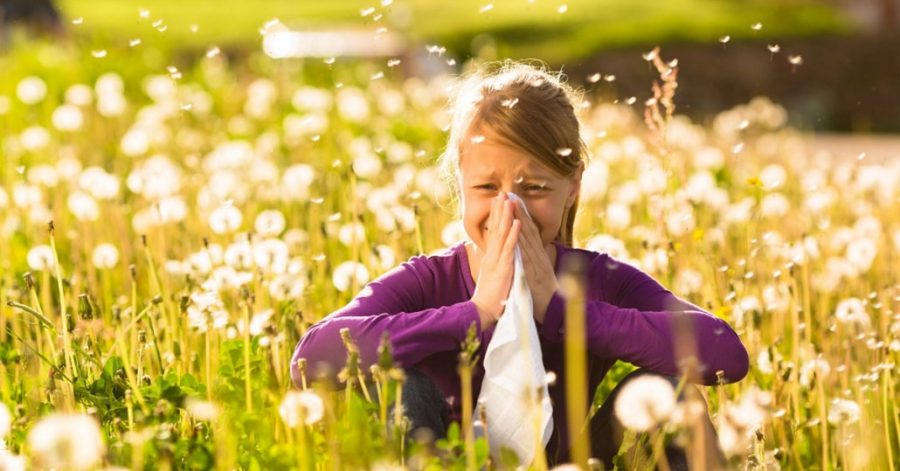Aachoo!
The warmer weather, while welcomed, brings with it seasonal allergies
Technically spring began on March 20, but for most residents living outside of Chicago, it arrived last week. Spring means the blooming of plants, warmer weather and the start of the MLB season, but for many, it also brings the burdens of spring allergies.
According to the Asthma and Allergy Foundation of American, nasal allergies affect about 50 million people in the U.S. The biggest trigger for spring allergies is pollen.
Allergies are triggered by tiny grains of trees, grasses, and weeds being released into the air in order to fertilize plants. These grains then enter a person’s body through the nose, causing someone who is allergic to react.
Triggers include trees such as; Elm, Oak, Pine and dozens of others, as well as grasses and weeds like Orchard and Saltgrass.
The immune system mistakes any potential airborne allergens to be a danger, and releases antibodies to attack, which then release chemical histamines into the bloodstream. The histamines trigger allergy symptoms such as a runny nose, watery eyes, sneezing, coughing, itchy eyes and nose, and dark circles under the eyes.
Over the counter and prescription allergy medicines contain antihistamines which act to reduce sneezing, sniffling, and itching by lowering the amount of histamine in your body.
To find out a definite answer of whether or not you are affected by these seasonal allergies, you should first go to your regular doctor, he or she may then refer you to an allergist for tests.
The allergist will put you through a skin test, either pricking the surface of the skin with a small amount of the allergen through a prick test or injecting a small sample of diluted allergen under the skin on arm or back.
I have undergone the prick test myself, and have to say it is quite painful. Upon my first visit to the allergist, I received more than 20 different pricks to test for all different types of airborne allergens. After the pricks are completed the doctor leaves them to sit (and they get excruciatingly itchy) for a designated amount of time before measuring them again and determining whether or not a hive or inflamed enlargement of the skin where the prick was inserted has taken place.
For some people, allergens are a seasonal annoyance that requires antihistamine to reduce the pestering symptoms. Those with food allergies, though, face a life- threatening condition that without a diagnosis can result in death.
The diagnosis process is fairly similar to that of seasonal allergies, except most often instead of skin test, blood drawing is necessary.
I suffer from allergies to peanuts, nuts, eggs, peas, beans, mustard, natural soy, and dairy. The first question many people ask when they hear me give off these list of allergies is, “What do you even eat?”
I know it may seem impossible with all of these dietary restrictions to get proper nutrition in my diet, but I assure you it is really not that difficult at all. Not to mention I am far from alone in this challenge. According to Food Allergy Research and Education, 15 million Americans suffer from food allergies.
The eight major food allergens include milk, egg, peanut, tree nuts, wheat, soy, fish and crustacean shellfish; these are responsible for most of the serious food allergy reactions in the United States.
My biggest recommendation for people facing food allergies, or those looking to help someone they know who is affected, is eating in. By eating at home you are preventing any sort of cross-contamination that could potentially take place in a restaurant, and you can stock up on all the foods you know you can eat, and physically read a label to know whether or not it is safe.
Labels that say, ‘processed in the same facility as…’, ‘made on the same equipment as… ’, or ‘may contain…’, any of the potential allergens are essentially companies disclaimer statements so if someone with that allergy has a reaction, they won’t have to face a lawsuit for it. To decide whether or not these foods are safe for you, based on the severity of your allergy it is best to ask your doctor or avoid them all together.
Some brands that specifically accommodate allergies include, Enjoy Life, Udi’s Gluten Free, Glutino, and so many more today do a really good job to accommodate millions with allergies. These foods tend to be more on the pricey side with a price tag of $25 billion annually for families caring for children with food allergies.
If someone does find him or herself suffering from an allergic reaction, EpiPen or Auvi-Q (with doses of epinephrine) for severe reactions, or Benadryl for less severe are options to carry.
Sublingual immunotherapy is the newest development in treating/finding a cure for not only seasonal but food allergies as well.
Without getting into the nitty-gritty science of it, it includes a three time daily dosage of small amounts of the allergen taken in liquid form under the tongue. Taking these drops in an increased dosage of the allergen over time help to build up a tolerance to the allergens, essentially tricking the body to tolerate it.
I have been on this program for two years with the Lacrosse Allergy Association and have already begun to see a decline in the severity of my allergies, and the goal is that after four years I will be able to tolerate the foods completely in their natural form.
So, there is hope, for both my fellow food allergen affected people and those of you dreading this upcoming spring seasonal allergies.


















